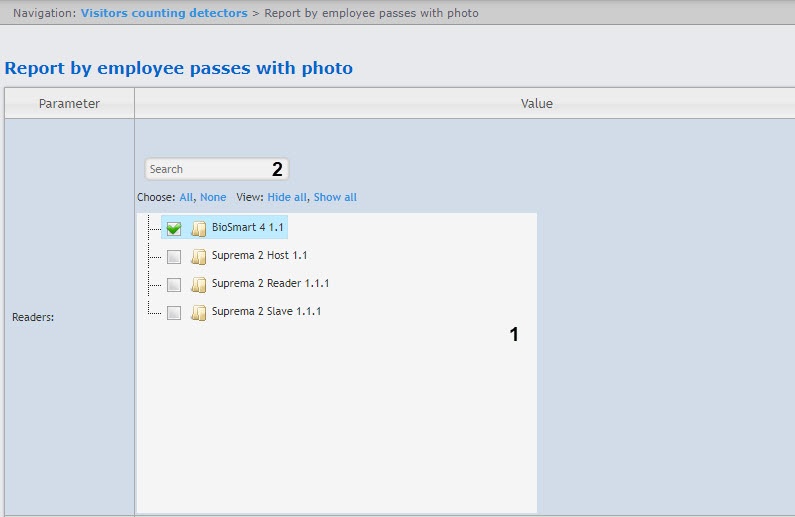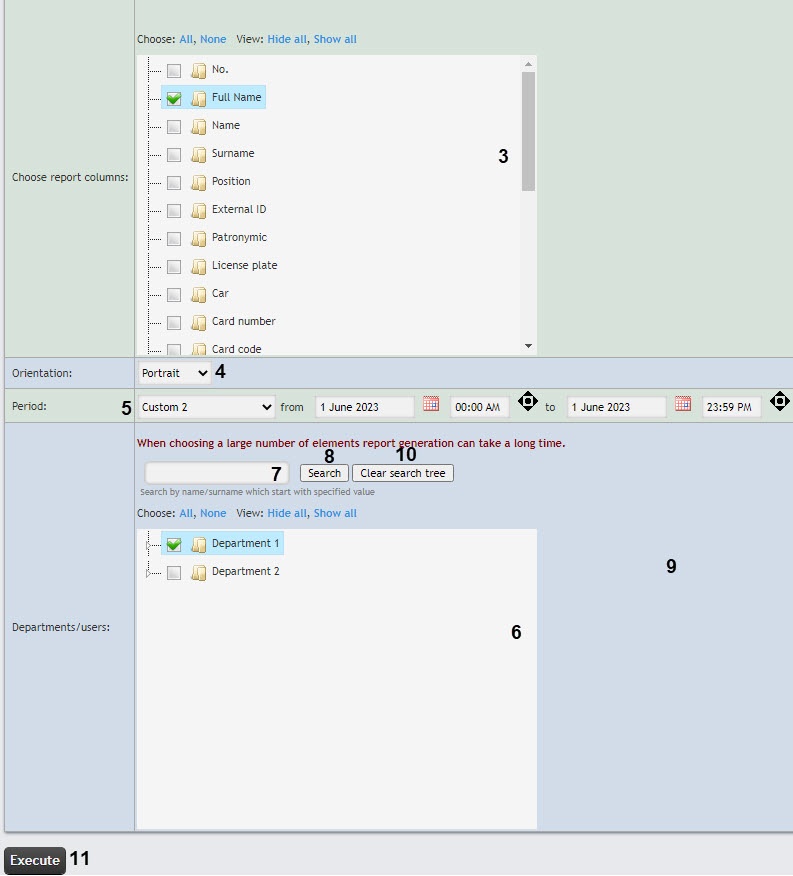Go to documentation repository
Documentation for WEB Report System PSIM 1.0.1.
The Report by employee passes with photo displays all interactions of the selected employee with the selected readers, displaying a photo from the video archive at the time they have passed the reader. The report allows you to track the movement of the selected employee within the specified zone.
Note
To build the Report by employee passes with photo, first you need to create and configure the following objects in Axxon PSIM:
- Create and configure the Web-Server object (see Configuring the videoserver to connect Clients via the Web-server module).
- On the List of cameras tab of the Web-Server object, add the cameras, from the archive of which photos will be added to the report (see Selecting and configuring cameras for the Web-server module).
- Create and configure the Web-Server 2.0 object (see Configuring the Server to connect the Clients via the Web-server 2.0 module).
- In the settings of the Video player of the Web Report System (see Video Player Settings), specify the Web-Server address and port.
- Link the camera to the reader by configuring the connection between them on the settings panel of the Objects link object on the Programming tab (see Connection of objects with cameras). Each reader must be linked to its own camera.
- When building the Report by employee passes with photo, Axxon PSIM must be running and the camera linked to the reader must have an archive record of the user's pass.
To build the Report by employee passes with photo, do the following:
- Select the Report by employee passes with photo (see Selecting a type of reports by Visitors counting detectors). As a result, the dialog window for specifying the report parameters will be displayed.
In the Readers field (1), set the checkboxes next to the access points, information on which should be displayed in the report.
Attention!
This field displays only those access points that have been added to any access level in the Access Manager module (see Creating access levels).
To use the search when selecting readers, in the search field (2) start entering the reader name. The search works starting from the first character. The results will be highlighted in a different color. Click All to select all found or available objects. Click None to deselect. Click Show all to expand the object structure. Click Hide all to hide the object structure.
- In the Choose report columns field (3), set the checkboxes next to the columns that should be displayed in the report. You can also change the order of the columns: to do this, use the left mouse button to move the column name up or down. Click All to select all available objects. Click None to deselect. Click Show all to expand the object structure. Click Hide all to hide the object structure.
From the Orientation drop-down list (4), select the report orientation: Portrait (vertical) or Landscape (horizontal).
Attention!
- In Portrait orientation, you can select up to five columns.
- In Landscape orientation, you can select up to seven columns.
In the Period field (5), select the time period for which you want to build the report.
Note
- If the Custom period is selected, enter the date of start and end periods for which the report is to be created in the from and to fields using the Calendar tool. Click the button near the corresponding field to use the Calendar tool.
- If the Custom 2 period is selected, additionally enter the start and end time of the period for which the report is to be created using the button.
- The Custom 3 period allows you to set the time interval from Yesterday (time) to Today (time) relative to the report date.
- In the Departments/users field (6), select the departments or users, information on which should be displayed in the report. Click All to select all available objects. Click None to deselect. Click Show all to expand the object structure. Click Hide all to hide the object structure.
- You can find an employee by their first name or surname using the search. For this, enter in the search field (7) at least 4 first characters of the employee's first name or surname and click the Search button (8). The department to which the found employee belongs will be displayed in the search tree in the area 9. To clear the search field and the search tree, click the Clear search tree button (10).
- To create a report, click the Execute button (11). As a result, the report with specified parameters is displayed.
All possible fields of the report are described in the table.
| Field name | Description |
|---|---|
| No. | Line number |
| Photo | Photo from the camera |
| Full Name | Employee's full name |
| Name | Employee's first name |
| Surname | Employee's last name |
| Position | Employee's position |
| External ID | Employee's external identity number |
| Patronymic | Employee's patronymic name |
| License plate | Employee's car license plate number |
| Car | Employee's car brand |
| Card number | Employee's access card number |
| Card code | Employee's access card code |
| Date of card issue | Employee's access card issue date |
| Access point | Access point through which the employee has passed |
| Date | Date of the passage |
| Date and time | Date and time of the passage |
| Time | Time of the passage |
| Access levels | Employee's access levels |
| Phone | Employee's phone number |
| Company | The name of the parent department, if the employee's department is a subsidiary |
| Department | Department where employee works |
| Comment | Commentary |
| Card expiration date | Employee's access card expiration date |
| Pin code | Employee's access card PIN code |



